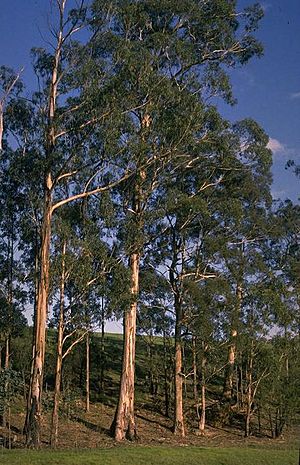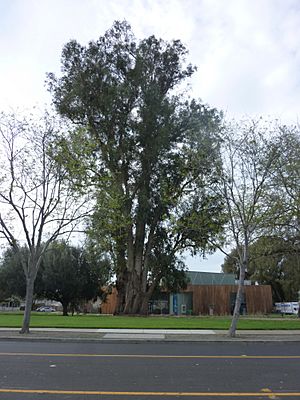Southern blue gum facts for kids
Quick facts for kids Blue gum |
|
|---|---|
 |
|
| Eucalyptus globulus subsp. maidenii | |
| Scientific classification | |
| Genus: |
Eucalyptus
|
| Species: |
globulus
|
| Synonyms | |
|
|
The Southern Blue Gum (Eucalyptus globulus) is a tall, evergreen tree that grows naturally only in southeastern Australia. It's famous for its smooth bark and unique leaves. Young leaves are whitish and waxy underneath, while adult leaves are shiny green and shaped like a spear.
This tree has special flower buds that are waxy and ribbed. They grow alone or in small groups in the leaf corners. Its flowers are white, and the fruit is woody. There are four different types, or subspecies, of Southern Blue Gum. Each type grows in specific areas of New South Wales, Victoria, and Tasmania.
Contents
What the Blue Gum Looks Like
The Southern Blue Gum tree usually grows to about 45 meters (148 feet) tall. But in perfect conditions, it can reach an amazing 90 to 100 meters (295-328 feet) tall! Sometimes, it might even be a small shrub.
Its bark is usually smooth and white to cream-colored. But at the bottom of the tree, you might see some rough, old bark that hasn't peeled off. Young plants and new shoots often have square-shaped stems with a clear ridge on each corner.
The young leaves grow in pairs and are directly attached to the stem (meaning they have no stalk). They are waxy, bluish-white, and shaped like an egg, up to 150 mm (6 inches) long. Adult leaves grow one after another, are shiny dark green on both sides, and are shaped like a spear or curved. They are 150-300 mm (6-12 inches) long and grow on a short stalk.
The flower buds grow alone or in groups of three or seven in the leaf corners. They are usually directly attached to the stem or have a very short, thick stalk. The buds themselves are often waxy or green and shaped like a top or cone. They have a flat, warty cap that pops off when the flower blooms. The flowers are always white. After flowering, the fruit becomes a woody, cone-shaped or half-sphere-shaped capsule.
How it Got its Name
The Southern Blue Gum was first officially described in 1800 by a French botanist named Jacques Labillardière. He found samples of the tree in Tasmania in 1792 during an expedition led by d'Entrecasteaux.
The d'Entrecasteaux expedition quickly used the tree's wood to fix their boats. Later, in 1962, the Tasmanian blue gum was chosen as the official flower symbol of Tasmania. The name globulus comes from a Latin word meaning "a little ball" or "small sphere," which describes the shape of its fruit.
In 1974, a scientist named James Barrie Kirkpatrick identified four different types (subspecies) of Eucalyptus globulus. These types are recognized today by how their flower buds are arranged:
- Southern Blue Gum or Eurabbie (Eucalyptus globulus subsp. bicostata): Its flower buds grow in groups of three and are directly attached to the stem.
- Tasmanian Blue Gum (Eucalyptus globulus subsp. globulus): Its flower buds grow alone in the leaf corners.
- Maiden's Gum (Eucalyptus globulus subsp. maidenii): Its flower buds grow in groups of seven.
- Victorian Eurabbie (Eucalyptus globulus subsp. pseudoglobulus): Its flower buds grow in groups of three and have small stalks.
Where Blue Gum Trees Grow
Blue Gum trees grow in forests in New South Wales, Victoria, and Tasmania, including some islands in the Bass Strait.
The bicostata subspecies grows in mountain and high plateau areas between northern New South Wales and the Pyrenees in Victoria. The globulus subspecies is mostly found in the lowlands of Tasmania, on some Bass Strait islands, and in the far southwest of Victoria.
The maidenii subspecies grows in coastal mountain ranges of southeastern New South Wales and eastern Victoria. The pseudoglobulus subspecies is mainly found in eastern Gippsland, but some isolated groups are further inland and in southeastern New South Wales.
You can also find Blue Gum trees growing in other parts of the world where they were introduced by people. These include Spain, Portugal, parts of southern Europe (like Cyprus), southern Africa, New Zealand, California in the United States, Hawaii, Macaronesia, and Chile.
Tallest Blue Gum Trees
Blue Gum trees usually grow between 30 and 55 meters (98-180 feet) tall. The tallest known Blue Gum in Tasmania today is 90.7 meters (297 feet) tall.
Some people in the past claimed to have seen even taller trees, up to 400 feet (122 meters)! While this might seem like an exaggeration, some environmentalists believe such tall trees might have existed but were cut down when Australia was first settled by the English. One person, D. W. Lewin, even claimed to have seen a tree 101 meters (331 feet) tall.
Blue Gum Plantations
The Blue Gum is one of the most widely planted eucalyptus trees in the world. It's very popular because it grows quickly and can adapt to many different conditions. It grows especially well in countries with a Mediterranean climate, which has warm, dry summers and mild, wet winters. It also does well in high mountain areas in tropical regions.
In Australia, Blue Gum makes up 65% of all planted hardwood trees, with about 4,500 square kilometers (1.1 million acres) planted.
Around 1860, Francis Cook planted Blue Gum trees at his property in Sintra, Portugal. Within 20 years, some trees grew to 100 meters (328 feet) tall! By 1878, the tree had spread across Portugal. It was also planted in Galway, Ireland, to help improve wet, boggy land.
In the 1990s, Blue Gum plantations started in the Los Lagos and Los Ríos regions of Chile. Because these areas are at the southern edge of where the tree can grow, good growth needs careful site selection, like sunny, north-facing slopes. Some of these plantations grow in red clay soil.
How Blue Gum Trees are Used
Timber
Blue Gum wood is yellowish-brown and quite heavy. Its grain is interlocked, which means the wood fibers twist together, making it difficult to dry properly. It's not the best for making lumber because of problems with growth stress. However, it can be used for building, fence posts, and poles.
Pulpwood
The wood from Blue Gum trees is also used to make pulp, which is then turned into paper.
Essential Oil
The leaves of the Blue Gum tree are used to make eucalyptus oil through a process called steam distillation. Eucalyptus globulus is the main source of eucalyptus oil around the world, with China being the biggest producer.
This oil has many uses:
- It can be used in medicines and treatments.
- It's used in perfumes and scents.
- It adds flavor to some products.
- It has properties that can fight germs (antimicrobial).
- It can also be used as a natural biopesticide to control pests.
The oil usually makes up 1.0-2.4% of the fresh leaf weight. A substance called cineole is the main part of the oil. Blue Gum oil is popular internationally because it has almost no phellandrene, which is important for medicines taken internally. In 1870, a scientist named Cloez named the main part of E. globulus oil "eucalyptol," which is now more often called cineole.
Herbal Tea
The leaves of the Tasmanian blue gum are sometimes used to make a herbal tea.
Honey
The flowers of the Blue Gum tree are a good source of nectar and pollen for bees, helping them make honey.
Blue Gum as an Invasive Species
Blue Gum trees were brought to California in the mid-1800s. One reason was that the Southern Pacific Railroad needed timber for railroad ties. Now, you can see them in many parks in San Francisco and across the state.
However, many nature experts and the United States National Park Service consider the Blue Gum an invasive species. This means it spreads very quickly from its seeds and can take over areas, pushing out the plants that naturally belong there. Local fire departments in California also see it as a big fire risk because it burns easily.
Because of these problems, programs have been started in California to remove Blue Gum trees and bring back the native plants in certain park areas. Examples include Angel Island in San Francisco Bay and the hills of Oakland, California.
Images for kids
See also
 In Spanish: Eucalipto blanco para niños
In Spanish: Eucalipto blanco para niños




